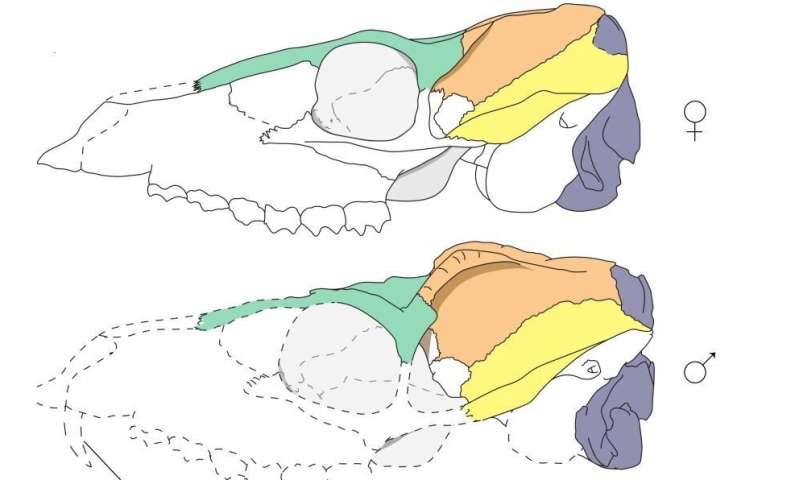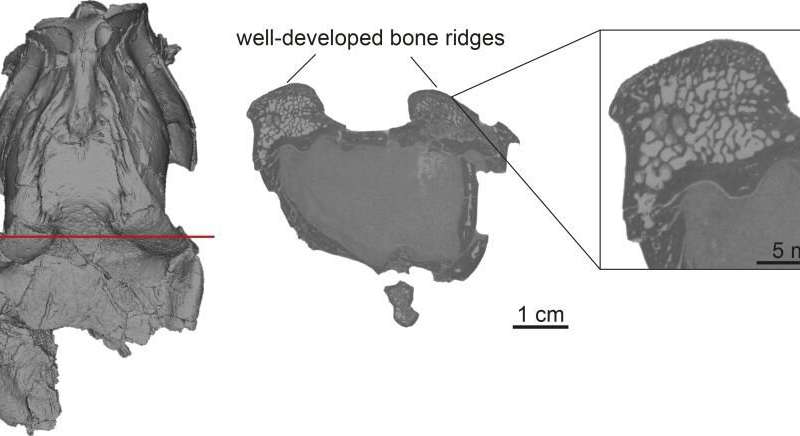Unexpected differences between males and females in fossil mouse deer

Mouse deer are among the smallest ruminants in the world. Today, they live in the tropics of Africa and Asia and are barely larger than hares. Males and females differ little in appearance. But that was not the case about eleven million years ago. Josephina Hartung and Professor Madelaine Böhme from the Senckenberg Center for Human Evolution and Paleoenvironment at the University of Tübingen came across a previously unknown difference between the sexes while examining two fossil mouse deer skulls from the Hammerschmiede clay pit in the Allgäu region of Germany. They discovered conspicuous bone ridges above the eyes on the skull of a male mouse deer; these ridges were not present in the females. The study was recently published in the journal PLOS ONE.
"In mouse deer living today, males differ from females only by enlarged and externally visible upper canine teeth," says Josephina Hartung, a doctoral student. These saber-like tusks serve as a weapon or demonstration of strength in fights between two males, she says. The extinct species, Dorcatherium naui, which lived eleven million years ago in what is now southern Germany, was slightly larger than today's species, Hartung says. They were contemporaries of the first upright walking ape Danuvius guggenmosi, whose remains from the same location were studied several years ago.
Air-filled bone structures
"What is unusual about the male mouse deer skulls from the Hammerschmiede are the well-developed bone ridges that enclose the top of the skull almost like a wreath," according to Hartung. This feature was previously unknown in both present-day or fossil mouse deer. Female mouse deer skulls from the same locality did not exhibit this feature. The researchers concluded that this must be a previously undiscovered sexual difference, also known as sexual dimorphism. A confirmation of this finding was obtained by comparing the finds with other fossil skulls of this mouse deer species.
It is interesting that the skull ridges of the male were filled with air, says Hartung. That was revealed by measurements using micro-computed tomography, an X-ray technique used to obtain three-dimensional images of the internal structure of small specimens, she says. "These data showed us that the ridges were not filled with dense bone material at all, but rather had many small cavities, similar to what we see in giraffes today." Whether these cavities served to reduce the weight of the skull or had some other function is unclear. "Possibly the ridge over the eye area protected the eye from combat injuries by the saberlike canines of another male, as is seen in Muntjak deer," Madelaine Böhme speculates.
-

Reconstruction of the female (top/left) and male (bottom/right) mouse deer skull from the Hammerschmiede clay pit. Credit: University of Tübingen -

Virtual reconstruction of the male mouse deer skull from the Hammerschmiede clay pit. Microcomputed tomographic data show the air-filled internal structure of the pronounced cranial ridges. Credit: University of Tübingen
Signs of an ecologically diverse family
The researchers also believe it is likely that the bone ridges served as a kind of display feature, as decoration to impress females or deter other males. Something similar is seen in closely related ungulates such as giraffes, deer and antelopes, which bear horn-like outgrowths, horns or antlers, they say. "The fact that the evolutionarily more primitive mouse deer had bone protuberances on their skulls is a first for the biology of these small ruminants," Hartung says, adding it suggests that mouse deer once formed a more ecologically diverse family.
"Once again, the excavations at Hammerschmiede have shown the unique potential of the fossils. They help us to learn more about the evolution and biology of extinct species," says Böhme.
More information: Josephina Hartung et al, Unexpected cranial sexual dimorphism in the tragulid Dorcatherium naui based on material from the middle to late Miocene localities of Eppelsheim and Hammerschmiede (Germany), PLOS ONE (2022). DOI: 10.1371/journal.pone.0267951
Journal information: PLoS ONE
Provided by University of Tübingen





















